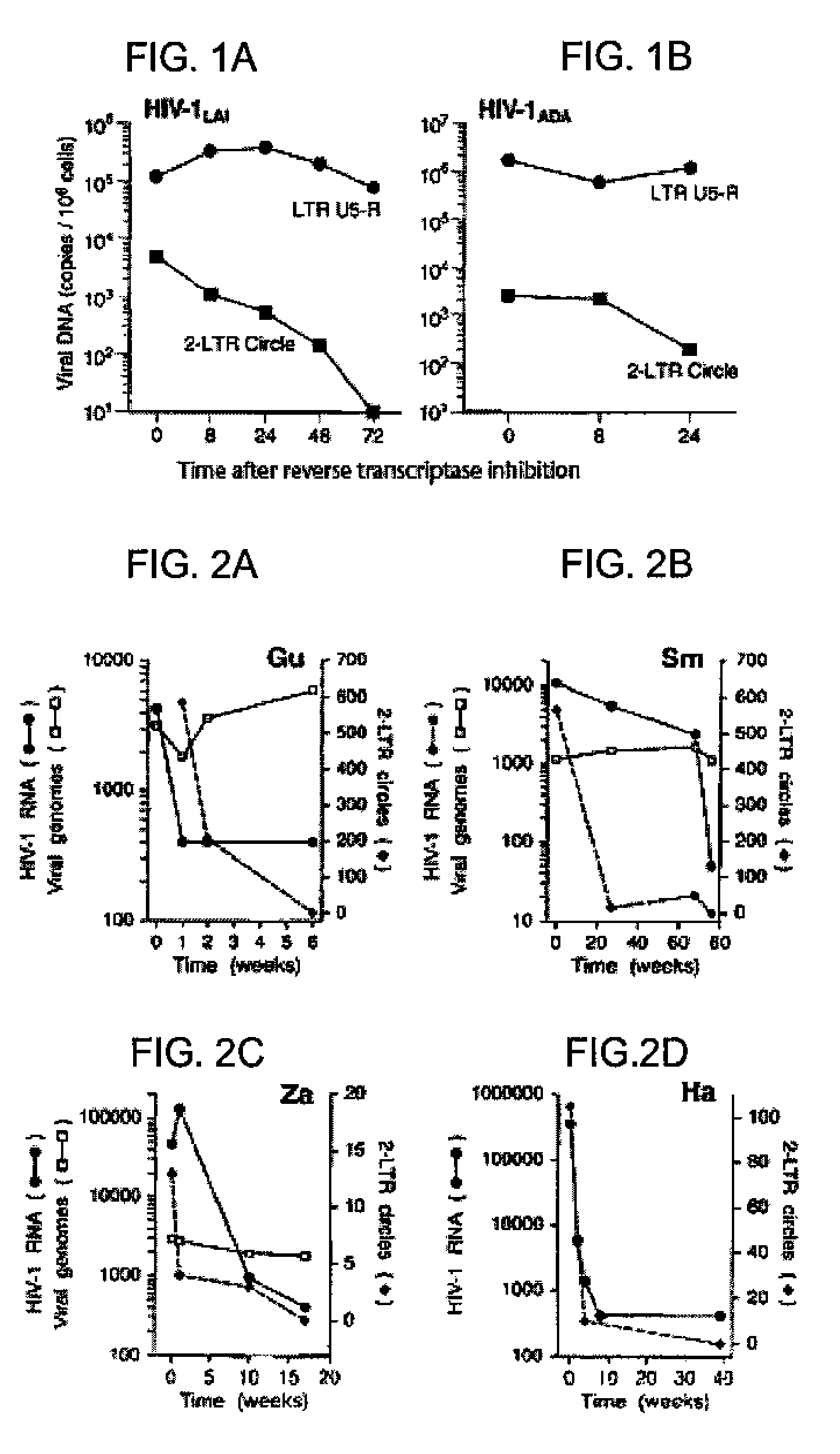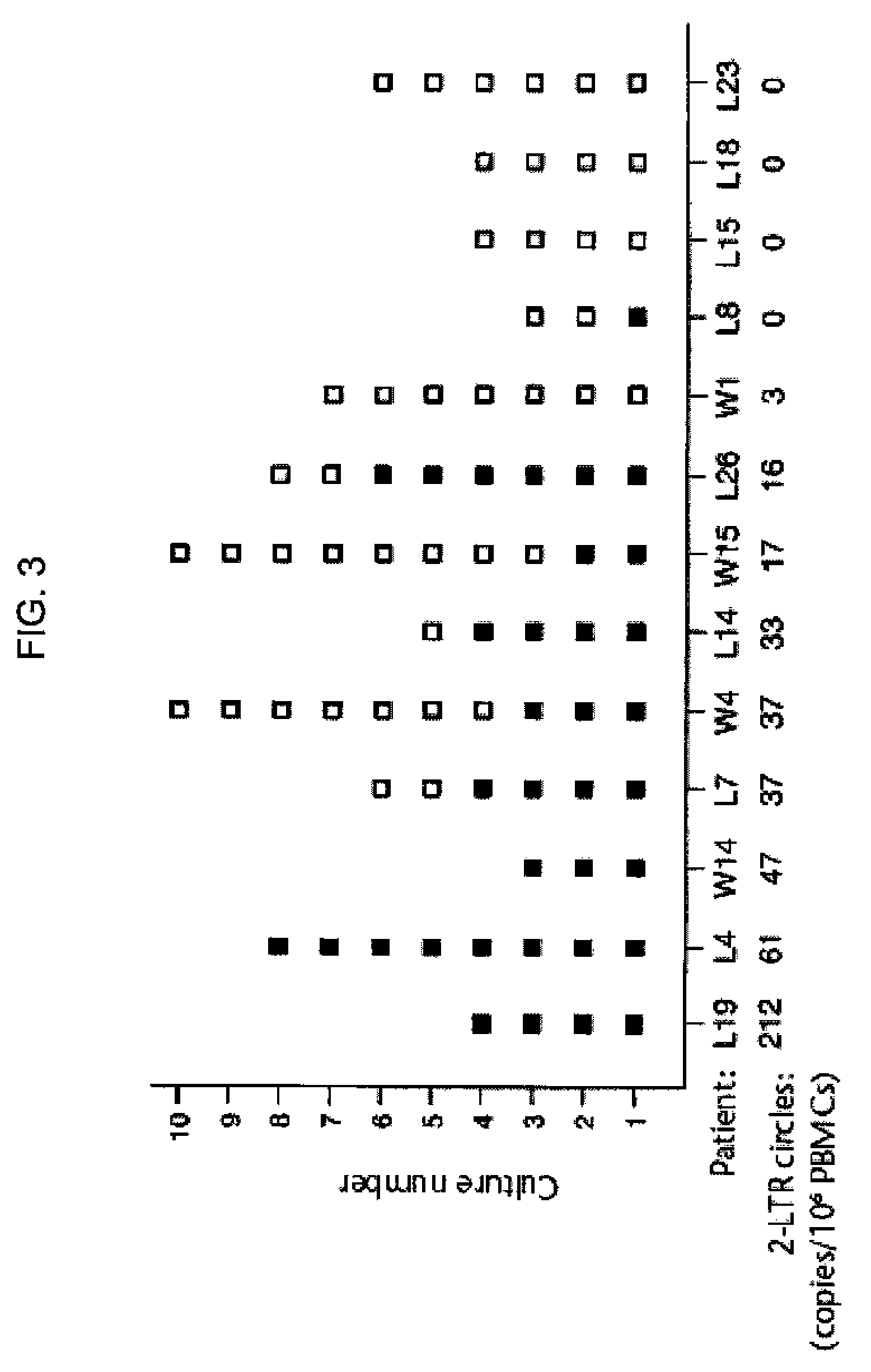Detection of human immunodeficiency virus
- Summary
- Abstract
- Description
- Claims
- Application Information
AI Technical Summary
Benefits of technology
Problems solved by technology
Method used
Image
Examples
example 1
[0035]Blood samples were obtained using standard techniques from 20 HIV-1-infected individuals who began and continued to receive combination anti-HIV drug therapy. All of these patients exhibited a period of time in which, after commencement of combination therapy, no plasma viral RNA could be detected by quantitative PCR. PBMC were isolated from each blood sample, and the extrachromosomal DNA was purified using the Spin Miniprep Kit available from Qiagen as Cat. No. 27104, generally following the manufacturer's directions.
[0036]HIV-1 2-LTR circles were detected by quantitative PCR using the 2-LTR-specific primers described in Stevenson et al., J. Virol., 64:2421-2425 (1990). The (−) strand primer spanned nucleotides 9591 to 9610 (or 507-526) of the HXB2 strain of HIV-1, while the (+) strand primer spanned nucleotides 9650-9669 (or 566-585) of the HXB2 strain of HIV-1 (Ratner et al., Nature, 313:277-284, 1985). Plasma viral RNA in each sample was also measured using the Amplicor HI...
example 2
[0039]The stability of 2-LTR circle forms of viral DNA were initially examined in acutely infected cells in vitro. CD4+ MT-4 T cells and Jurkat-CCR5 cells were infected with the X4 variant HIV-1LAI and the R5 variant HIV-1ADA, respectively. Synthesis of viral cDNA was allowed to proceed for 24 hours, and further rounds of virus infection and cDNA synthesis were then restricted by the addition of reverse transcriptase inhibitors ZDV (5 μM) or Nevirapine (1 μM) to HIV-1LAI and HIV-1ADA infected cells, respectively. Cells were then maintained in the presence of the RT inhibitors.
[0040]The experimental procedures used in Examples 2-4 are briefly described.
[0041]The relationship between 2-LTR circle frequency and either the duration of undetectable plasma viral RNA or the frequency of positive virus co-cultures was examined using Spearman's correlation coefficient. Mean frequency of positive co-cultures in 2-LTR circle positive individuals and 2-LTR circle negative individuals as shown i...
example 3
[0047]Whether 2-LTR circles were labile in vivo was next evaluated. PBMC samples were obtained from four HIV-1 infected individuals (Gu, Sm, Za, Ha) who, following adjustment of their antiretroviral regimens to more potent combinations, exhibited steady declines in plasma viral RNA levels. Patient Gu, who had been maintained on a two-drug RT inhibitor combination, was subsequently changed (week 0) to a three-drug regimen (ZDV / 3TC / NFV). Patient Sm, who had been on a two-drug regimen (ZDV / 3TC) was changed at week 68 to ddI / EFV / NFV. Patient Za, who had been on a four-drug regimen (3TC / D4T / ddI / NFV) was adjusted (week 1) to ZDV / ddC / NFV / RTV. Patient Ha, previously on a three-drug regimen (ZDV / ddI / NVP) was subsequently adjusted (week 0) to D4T / 3TC / NVP. Marked declines in 2-LTR circle copy number were observed over the interval in which there was a rapid drop in levels of plasma viral RNA (FIGS. 2A-2D). In contrast, when samples were analyzed in parallel with internal LTR primers, HIV-1 vir...
PUM
 Login to View More
Login to View More Abstract
Description
Claims
Application Information
 Login to View More
Login to View More - R&D
- Intellectual Property
- Life Sciences
- Materials
- Tech Scout
- Unparalleled Data Quality
- Higher Quality Content
- 60% Fewer Hallucinations
Browse by: Latest US Patents, China's latest patents, Technical Efficacy Thesaurus, Application Domain, Technology Topic, Popular Technical Reports.
© 2025 PatSnap. All rights reserved.Legal|Privacy policy|Modern Slavery Act Transparency Statement|Sitemap|About US| Contact US: help@patsnap.com


